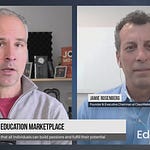Readers of this newsletter know that a little while back I published a piece titled “Why System Transformation Is Likely a Pipe Dream: But I’m for System Replacement.” That piece referenced a white paper by Thomas Arnett of the Clayton Christensen Institute titled “K–12 Value Networks: The hidden forces that help or hinder learner-centered education.” Tom collaborated on that white paper with our friends at Education Reimagined.
After publishing my piece, they both reached out to dig deeper into the conversation and its implications. That conversation is what I’m bringing you today. Is school transformation possible without replacing the existing education system? In addition to Tom, Kelly Young of Education Reimagined joined me to argue that it’s not. In an educational landscape that constantly seeks marginal improvements, my guests spoke to the importance of embracing new value networks that support innovative approaches to learning. The conversation touched on the issue of programs that remain niche solutions, rather than robust, learner-centered alternatives. In exploring the concept of value networks, they both challenged the notion of transforming individual schools or districts alone. They argue for the creation of a new value network to truly revolutionize the education system. Of course, they admit that achieving this is no small feat, as it requires a paradigm shift in mindset and a careful balance between innovation and existing structures. In this conversation, we wrestle with the full implications of their findings and more. For example, I asked them if we just instituted more growth-based measures of learning as opposed to point-in-time and deficit labeling accountability approaches, would today’s schools and systems really not be able to respond? And if the answer is no, how separate does a new model of schooling really have to be? Can districts do this work? Their answers were illuminating.
As always, subscribers can listen to the conversation, watch it below, or read the transcript.
Michael Horn:
Today, we have two folks who been at this work for a number of years in reinventing our education systems and our schools and rethinking a lot of the fundamental assumptions really that undergird them. We have Kelly Young, who is the president and founder of Education Reimagined. Kelly, it's good to see you.
Kelly Young:
It's great to see you. Thank you for having me.
Michael Horn:
Yeah, especially fresh off vacation, to have you here is a luxury for us. And then we have Thomas Arnett. Tom, you've been on the show before, so it's good to see you again. Obviously, Tom is a senior researcher at the Christensen Institute. He and I have been colleagues for many, many years now. I think you just passed your 10th year anniversary at the Christensen Institute.
Tom Arnett:
I did.
Michael Horn:
So congrats and good to see you as well, Tom.
Tom Arnett:
Yeah, great to see you, Michael. Great to see you both. Two of my favorite people to chat with, so I'm excited for this conversation.
Morning Warmup
Michael Horn:
Well, hopefully you'll still feel that way by the end. But as folks who listen know, we separate this show into four segments, and we're going to dive right into our morning warmup. And I'll start with you, Tom, and I'll give a little bit of background and the reason we wanted to have this conversation. You all had collaborated on a paper a number of months ago that came out that I used in my class at Harvard. It's a great paper called “K–12 Value Networks: The hidden forces that help or hinder learner-centered education.” And the big argument, I think, if I were to summarize it, is that schools are a part of a larger systems surrounding them, whether that's the school boards, the unions, the policymakers, they exist in an ecosystem and a network of different organizations that are impacting them in different ways. And that if you really want to transform, it's not enough to just transform an individual school or an individual district. You kind of have to tackle the whole system itself. And that often means creating a new value network entirely. And so then I followed this up some months later because I was frustrated, I think, coming out of GSV, where I saw both of you and everyone was saying, like, how do we change the system? And I was like, we don't change the system. We replace the system with something completely new. And so I wrote this piece, why system transformation is likely a pipedream, but I'm very in favor of system replacement, and we thought we'd geek out and talk a little bit about. So, Tom, I want to start with you, which is like, I did my best to summarize the paper but I'd love you to give a little bit more of the basic argument behind why you really need a whole new value network if system changes what you're after and the logic behind that conclusion.
Tom Arnett:
Yeah, well, let me dive right in, Michael. I think all of us on this conversation share this common view that education could be a lot better than it is and that it's not just about tweaking curriculum or tweaking the professional development we give teachers that there's some fundamental things that should be rethought about the idea of single paced, classroom based, teacher driven instruction. Now, folks have been calling out the conventional model of schooling for probably close to a century, know Dewey. But we also can look and see that folks like Larry Cuban and David Tyack for decades have been pointing out that, yeah, people tweak the system on the margins, but that fundamental, what they call the fundamental grammar of schooling or the fundamental our language in the paper would be the fundamental organizational model of schooling hasn't changed. And so this paper really draws on insights from outside of education that are super relevant here. Clayton Christensen, when he was studying organizations was asking this question why is it that large, successful, well resourced companies consistently fail to adopt certain types of innovations? And what he ultimately landed on was the idea of value networks being a key driver of that phenomenon of why companies often don't innovate. So in a company context, the value network is your customers, your suppliers, your distribution channels, your investors. But in education, we look at the value network as being made up of things. It's essentially the context of individuals, other organizations, institutions and regulations that interface with and establish help an organization establish its model. So for a school, the value network often includes local, state and federal education agencies, policymakers, learners and their families, employee unions, voters and taxpayers, the post secondary education system, community organizations, vendors, teacher preparation pipelines, philanthropic donors. That context that value network for schools then becomes the dominant influence on its priorities and it shapes what types of innovations will you do? But it also determines what types of innovations just don't pass muster, don't get traction because they don't align with what that broader context demands. So we wrote this paper to really point out if we want to get to new models of schooling that break free from the conventional grammar of schooling, we can't just do it by trying to take existing schools and tweak them, adjust them. Because not only do their models have a lot of inertia that's hard to overcome, but the value networks, they sit within the expectations that policymakers and parents and others have of what those schools are supposed to offer and how they're supposed to work. Those forces just push schools back into a more conventional model. So again, the high-level takeaway is if we want new models, we have to find ways to assemble new value networks around those models to support those models.
Michael Horn:
Super helpful description. And Kelly, I think for all of us it rings true. But your background is one where you came into this question of reimagining education through this organization called Convergence, which, in essence, if I tried to summarize it, would be you take sticky areas where there's two sides, broadly speaking. Or multiple sides, perhaps, that don't necessarily agree, and you take them through a process to come up with convergence, like a new set of views, if you will, that all sides can take to. So I hear that and I'm like, okay, these folks think that they can somehow get system transformation by getting all these different stakeholders in the value network to speak the same language. And indeed you came out with this incredible statement that undergirds education reimagined about what education could look like. And then here you are writing a paper with Tom and espousing a lot of these same ideas that it's not going to happen in the existing value network. So I want to know, that feels like an evolution, maybe it's not. You'll tell me, but how did you come to that conclusion?
Kelly Young:
Yeah, it is somewhat of an evolution. It was an evolution watching transformational efforts over the last ten years when we came out with the vision. So rather than ask people to come to common ground, we actually asked them to set aside the legacy system and imagine what you would invent today, what we know about kids development, society, learning, education, et cetera, and ask them to really imagine the future. And there was no question that there was agreement on what that future was. And it was what we call learner centered education. And it really is around about human thriving as opposed to consumption of knowledge, right? And rather than compliance, it's about agency. So even at the time, if you read the vision document, it goes through everything that would have to be redesigned from the preparation of adults, the adult roles assessment, credentialing of learning, funding models, you name it. It would have to be redesigned because in our current system, it is all designed for standardization, compliance and knowledge transfer. So we knew all of that to begin with. And in some ways it's not a radical shift. What we're proposing, what we've always known, is that you have to find the people who want to do this invention of a new system and that it is invention at this point. It's not about taking something and scaling something. There are models that exist. Montessori, for example, right, is a learner-centered model of education. But until you have systems transformation where that would actually enable that model to thrive and exist and be incentivized, you are not going to see those models significantly spread inside of public education. And our mission, just to be clear, is about creating a public education system that a learner-centered public education system. So we have watched people trying to do it inside the system and outside of the system. We are really about finding people who see this vision and are making instances of it for children, whether it's in charter district, out of school time homeschooling, et cetera. And we kept seeing this tension that people were trying to do it in system because that's where the money and the kids are. But they were highly constrained in what they were able to do because of the values networks. Then we were watching people going outside and seeing that they could actually assemble values networks that were aligned to what they were doing but they had no funding and they had no enabling infrastructure to do it. So if you think of microschools and pods and other interesting things that are happening outside of the system so we just got really clear that without creating a values network that is aligned to the work, some element of it is going to pull you back. Whether it's the school board, parent views, funders, state regulatory bodies, teacher certification, there's just too many whack a moles to get them all. Unless you're able to actually assemble a group of people who want to invent this future together.
Work Cycle
Michael Horn:
No, that's super helpful. Super helpful and that evolution makes sense. I think in light of that list that you just provided, that's a daunting list to move any one of those, let alone all of those. Let's move into the work cycle where I want to give you all a bunch of the yeah, buts that I get when I've come out with my piece or that I hear often and have you react in essence and see sort of how you frame it. Kelly, I'll start with you because I think one question we often get, at least I get, is like yeah, that may be right, but do we really need to change the system? If we just keep improving on the margins, that'll be fine. So is system transformation really the thing that's needed? I'd love to have you react to that one.
Kelly Young:
Yeah, I mean, I wish it wasn't because systems transformation is really difficult. But the reality is I was just looking at the stats and I apologize. I can't cite the report, but the instances of mental health, for example, and how dire that situation is for the youth of this country now and that comes from not having a sense of purpose, a sense of belonging, a sense of what they're learning makes a difference. That they make a difference. And adding a handful of things, moments of silence, social and emotional learning, adding a project here or there is not going to fundamentally shift that sense for them. And so it is unfortunate that systems transformation is necessary. But we have been trying for decades now to take this system and get it to marginally move on. Even the things that the system recognizes are critical, like NAEP scores or state testing. And it can't move it, let alone on social and emotional learning, sense of purpose, employability access and sustainability through higher ed. So if we really care about kids getting the results, systems transformation is really the only way we've got forward.
Michael Horn:
Yeah, it's interesting hearing you just say that and I'll just riff off of it before I go into the next question, which is, if you think about all those you said, moments of silence or meditation or social emotional learning or whatever, these add-ons. Not that any one of them is bad, but fundamentally, the system is still if at the end of the lesson, you still move on to the next one, regardless of whether you've mastered it. And agency and purpose is at the heart of your challenge. Well, you've just told people, like, actually, you don't have agency over whether you can keep working to control something. And so the system keeps unambiguously sending these signals that undercuts a lot of these well meaning activities, I think fundamentally, and you just laid out, I think, a nice list of, yeah, those are wonderful things, but they're still not changing the fundamental gears of the systems. So I want to go to the next one, which is like but surely there are anomalies to this idea or that we can do something differently. And the one that I often hear and Tom, I'll start with you on this. But Kelly, I'd love you to weigh in as well, which is if we put in competency-based learning policies, like we wiped out Carnegie units and seat time and maybe we changed the incentives. Kelly talked about incentives so that a Montessori model as an example could really thrive. And so we moved to maybe more growth based measures of learning as opposed to point in time and deficit labeling and things of that nature, then surely if we change what we pay for, these schools and systems could start to respond. What's your take on that one?
Tom Arnett:
So my initial reaction, I have so much sympathy for district administrators because their value networks are really messy. They've got a whole populations and communities of parents that want somewhat similar, somewhat different things. They've got state policymakers that are pushing them on different angles, federal policymakers that are pushing them on different angles. They're teachers unions, they're community stakeholders. And the nature of their institution is they're expected to serve all of these groups and give them all what they want and all what they need. And it means that they're in this tug of war where I often look at the status quo and I think, well, this is the natural equilibrium that you get when you have all these different forces from their value network pushing and pulling on them and they're doing the best they can to appease all these forces. So then to get to your question around like, well, why can't we just change the policy, change the incentives. I think what's often problematic is that we end up passing a policy that just layers one more force into that messy set of forces that are pushing and pulling on them within their value network. So you may get like a little nudge. There a little nudge here, but it doesn't have the ability to fundamentally realign the value network. I think of New Hampshire, my understanding is they've had competency based policy for a while and there are some really cool programs in the state of New Hampshire like VLACS that we profiled in our paper. But by and large, the competency-based policy hasn't fundamentally led to the redesign of widespread redesign of the districts across the state. And I think it's no one's fault. It's not that anyone's trying to become a nuisance or a hindrance to change. It's just the nature of the value networks that a conventional system sits within. It's really hard to tweak a policy or tweak an incentive and actually get a complete realignment of the organizational model and the priorities that that model is set up to pursue.
Michael Horn:
Kelly, what's your take? I mean, maybe we just need more patience with that change.
Kelly Young:
So the other part about for at least learner-centered education is that it is a paradigm shift. It's designing a system for a different purpose than our existing system is set up for. So when we talk about values networks, we're not talking about slight modifications like the experience of a child learning math for example. That would be a reform that you could institute. There are five elements that the vision document laid out for what learner centered is and competency based is one of them because you need to be able to credential learning no matter where it happens, wherever it happens, at whatever pace it happens with, whoever it happens with. And we actually thought at the beginning we have a star in the vision document and we had competency based at the top because we thought if you change that one, you change everything because that's a structure that we thought is keeping the whole thing in place. It turns out a, there are many structures keeping it in place but mostly there's a mindset keeping it in place. And so a structural change is not sufficient to cause a mindset shift. You need the mindset shift first and then to employ the structural change to support that mindset shift so you can find places where they are using competency based legislation to totally redo single sites learning like Iowa Big for example, in Cedar Rapids or many places that we all know. But the mindset shift for us is a shift between that we are preparing kids for the future, they are living now and they have contributions to make now. And that the idea is that we're not trying to help them fit in to a preexisting slot. We are helping them be lifelong learners so that they can create their lives and live fulfilling lives. And those two trajectories are radically different. And so it does take competency based ways of learning to fulfill on the new paradigm. And competency based in the existing paradigm for our existing system is actually just a lot of busy work to allow for self paced learning. And so it does add value to have self-paced learning. But it's a lot of work to do it and insufficient to actually change the experience of kids more than marginally. There's a whole host of other things that you would need in addition to competency based. So that's part of what's been a radical shift in our thinking. We actually realize that the mindset shift and that is really around agency and relationships have to be at the core of things first before any structural change will suffice.
Michael Horn:
Super intriguing point. I want to come back to that in a few moments and maybe once we end up we'll end with that thought because I think that's a very powerful idea. I want to go to another yeah, but that I get first though. Which is but look at this great thing have and you Kelly, you mentioned Iowa Big, right? I got one in higher ed recently. I made an argument that sort of these policies that states try to pass and different foundations try to fund of getting colleges to accept transfer credits from other colleges. It's not really going to work because fundamentally, we're still not credentialing learning. At the end of the day, we're credentialing seat time and asking these recognitions and there's business model issues and there's questions of faculty saying like, well, what you learned over at that college over there is not equivalent to what I teach here. It's not good enough for my major. Or like they have all their ways, right? And a few folks, several folks reached out and were like, you're wrong. Look at this great demonstration project we have here. Or look what we did in Florida. Or look at this. And I'm like, yeah, again, you're pushing on the margins. That's great. But I don't think you're not going to fundamentally change the system was my thought. But I want your thought because like pointing at the great thing. I'll give you another example. There are 500 public Montessori schools that are public schools, right? So there does seem to be room for them. Why can't those great things just sort of grow and thrive and prosper and change people's mindsets over time? Kelly, why don't you take this first and then Tom, you get it next.
Kelly Young:
Yeah, I mean I was definitely in the camp that thought if you find the models, they can spread. And if you network the models together to work on systems transformation, systems transformation will happen. Turns out it was not true and for a variety of reasons, but mostly because without that, systems transformation is a critical component because these things are roses and concrete now it's not as though they are growing in fertile ground to continue to multiply. Their seeds fly off but they land in fertile context. So the question is how do you get to systems transformation? And I guess our thought was people will rise up, they will shift the context that they're operating in and begin to shift systems but the reality is that is not what they are tasked with. Even if you are a single model that is not your job to figure out how do we do assessment credentialing of learning in alternative ways at scale that takes a completely different skill set, a different set of people to be involved with it. And until you have those things that make this an easy shift, that make this a scalable shift, things are going to stay in small pockets and it led us to have a radically different strategy going forward from simply identifying pioneers and networking them together. Tom, actually we are now about how do we pilot and demonstrate alternative public education systems in a handful of places because we believe that until you can invent systems that actually would enable this that's what will spread. The models can't spread until you have the enabling systems and tom date we really have been uninterested as a country in what would it take to invent those new systems that are scalable.
Tom Arnett:
Well, I'm going tom add nuance in that I'm going to recognize I think the marginal improvements are worthwhile. I think as folks are trying to create a new system shift to another paradigm, the work that other folks are doing of trying to improve the system we have is not without merit. The second thing I want to call out is that I'd be really curious to go look at those yeah but for instances and see how many of those actually have accomplished what they accomplished because they have a different type of value network supporting them because that's what I've seen and a lot of the examples. One thing to point out is that new value network does not necessarily have to mean outside of public education or outside of school districts. There's places within school districts, we profile some of them in the paper where they are coming up with very different approaches to education. But they found a way to kind of assemble a different type of value network within that public education landscape, which often means they find kind of exceptions or loopholes in policy or just places in policy where they can do things differently. It means that they're often serving different types of learners and different families with different expectations about what schools should be. And so their forces align, their value network forces align around doing something different. All that being said though, I will say that often those programs get stuck and one way in which I see them get stuck is that you create a new program that's kind of cool niche on the margins, but it never improves. It's like we created this really cool program for alternative education, for dropouts, and we are now checking the box that we've got dropouts back engaged with the system. But it's not becoming a really robust, learner-centered program. It's just kind of this niche program on the margins that no one's expecting to become more than just this stop gap. So that's one problem is I think you need leaders with vision to say, no, let's use this as a ground to invent new models of schooling, not just let's plug a hole and then walk away and go back to our day jobs. The other problem I see, though, is sometimes these programs do improve and they become really compelling, and then they get throttled. So a couple of programs I've seen within districts where they've created really compelling, learner centered versions of education, and they're getting really great test scores. And they'll often say, yeah, the district loves to feature us when people come to visit, they take them on a tour and they show them our site, but we can't grow anymore because our building only holds 200 or 400 kids. And the district has said, we don't want you to grow. You're a cool program, but we don't want young to affect the enrollments in our conventional schools. So we have to limit you and kind of keep you caged in that space. So that's where I hope that some of the impact of the work we're doing is to help superintendents, state policymakers, help them have the vision of look, not only how can we create the context where new programs and new value networks can emerge. But how do we also protect them and give them the runway they need to improve and grow and not just be relegated to these really neat boutiquey niches of the system, but never allowed to become mainstream alternatives to conventional education?
Specials
Michael Horn:
So I want to jump in, and I'm going to jump ahead now of where I was going to go, and we're going to go into our special section because this is where I want to push you both a little bit. And See is carving out an area within a district. Kelly separate enough? Like, how separate does it have to be? And the reason I'm asking it is because isn't that still in a value network of the district board or the colleges or whatever else? And what I think I often see and Kelly, I think you alluded to this a little bit also, which is like, yeah, maybe you see that great example. It's not their job to rearchitect the system, and frankly, over time, they sort of fade out or there's a regression to the mean, if you will, because the system still has its underlying incentives, and you can pick the five that pull it back, but that's five of 50 that could have pulled it back.
Tom Arnett:
Right.
Michael Horn:
So I'm just sort of curious, in your viewpoints, how separate does it really have to be? And are some of these examples that you've cited within districts, are those really the right mental models for us to pin? Tom tom, why don't you go first on your view and then Kelly?
Tom Arnett:
Yeah, well, as backstory, Michael and I have had some back and forth on this one. I think it's a real challenge. I think of it kind of like a gravitational pull, right? Like if you can get out of the Earth's gravitational pull, there's a place where you can be a satellite to the Earth and you can do things a little bit differently. But some of the things we want to see it takes really escaping that gravitational pull beyond just kind of being in orbit of it. And I think that's a challenge. As you launch a program within a district, there's a poll to bring it back to where it's at. And that's real. I think the counterpoint to that is the stuff happening in what some folks refer to as permissionless education. I mean, permissionless is about getting totally free of any kind of conventional value network. I'd say though, there's its own set of challenges over there. In terms of open, there's a lot of open space to do stuff. But in terms of finding the funding and finding the support, it's got its own set of challenges. I actually think it's an interplay of both that we need innovation happening both within districts and in the spaces outside of districts. Both to see the different versions of what's possible and to push each other a little bit to try things that are different.
Kelly Young:
So our view is I would love to believe that it's possible inside of districts and that you could carve out the space. And for all the reasons we talked about, those value network that are very volatile, they're constantly in flux. It is very hard even if you get something going to sustain it long enough. But that's not the only issue with it. In every other industry we have R and D space where we know that you do not invent something new with the people who are tasked with producing the existing resources, whatever it might be, right? You just wouldn't do it. You don't go to the car manufacturers and say let's invent flight because they have to continue to make cars. They have the tools to make cars, they have the incentives, all of those things exist. And yet, for some reason we think going to the people who are tasked with administering the existing system, they are going to have the time, the space, the funding, the resources, the talents. Because to invent a new system of education is not an easy task. You really have to be standing in a very different place. And if you're also tasked with administering the current one, you're always intention. So to. Me. It is not because of the lack of will, the lack of talent, the lack of vision for lots of people in districts that are trying this. It's that it isn't the right conditions to actually do this work. And it's also a misplacement of what we are doing or a miscategorization of the stage we're in. I keep talking about invention, and it's because so often in education we see a model and then we say, let's scale that model. Rather, what we have to do is create the conditions for models like that and many others like that. To be able to spread and to create those conditions is a very different task than creating a model. So I'm not willing to say, no, that you couldn't do it that way. We are just looking at education. We imagine what are the conditions and how can you get those conditions. I am very skeptical that you could get them in a district without significant resources going towards it and really examining how separate it is. I do think it would need separate governance because of the value networks. It would have to have people who are completely opting in from the educator perspective as well as the families and youth. And that the existing system that's sitting side by side with it is not administering the funds to the new because that's the other issue. As one begins to grow, as the new alternative grows, there's a lot of incentive for the existing system to also thomas's earlier point throttle it right to pull it back. So you also need to know that the funding of it is not controlled by the people who have an incentive to kill it.
Michael Horn:
No, that makes sense. Okay, so let me go into my penultimate question then, from there, which is I love that phrase, create the conditions. Kelly, that you just used. I think that's a really good one. And Tom, you mentioned the permissionless space and this is the zone of Education savings accounts and some of these other efforts to create, I think, more room for permissionless education, but still with public financing. And I'm curious your views of that theory of action, both of you. Kelly, maybe you can go first on this one, but is that what we're pinning our hope on right now, to have the space to reinvent and do systems change or are there other ways or mechanisms that you would see us creating the conditions to have a novel public education systems?
Kelly Young:
Yeah, one, I believe if you can get state funding and federal funding to support the R&D, that's where we want to end up. Whether at this stage we could get it free from the constraints of the existing system seems very difficult and it has not happened to date. And so I think it's going to have to be philanthropically led in the early stages to actually develop the R&D for this. And it will be important to have the philanthropic support because if it's only done on parent tuitions and parent support, you're going to be building a system that is only designed for some and you will not actually be designing something that works for all children. And I think if governments are risk adverse, right, policymakers are risk adverse and so they are not typically the places where you get the cutting edge ideas from. It is usually from, at least in industry, right from the marketplace. And because we don't have a marketplace in education, we have to create the spaces. And I think that's going to have to be philanthropically supported. And once young get some things that are working and people can see that where kids and parents and educators are loving what they're experiencing, then I think you could begin to get state and federal money to go deeper, expand, broaden the pilots and the prototypes.
Michael Horn:
That's helpful. Tom, before you give your reaction to the ESA permissionless, et cetera, world, just one quick thought actually off of what Kelly said and check me on the nuance. I think what you're saying, this R&D sector, there's similarities to what Joel Rose and Transcend and some of those folks have talked about like an R D for model providers. But I think what I hear you saying is, yes, but that's not sufficient. They also need R&D to create the new system by which those model providers thrive and live in and so forth. Am I hearing that correctly?
Kelly Young:
100%.
Michael Horn:
Okay, perfect. It strikes me as a really important nuance. So Tom, let me turn to you then on this ESA permissionless question. How do you frame that effort, in your view? Could this be the separate enough space?
Tom Arnett:
I think it can. I think there's a lot of promise. Again, from the perspective of how do you create a different value network? It allows for removing a lot of the forces that push and pull existing school systems and saying, let's create a value network that can align around what do learners and families need without a lot of other pressures pushing and pulling in different directions. I do want to say kind of add some caveats and say that when we talk about what is learner centered education and our vision for learner centered education, I don't think permissionless guarantees that every program coming out of permissionless education is going to be learner centered. It's one way to create the conditions where folks that are innovating and building new models could create those types of models. But it doesn't guarantee that every model is going to be good or every model is going to be learner centered.
Closing Time
Michael Horn:
Super helpful. Okay, let's go to closing time. You all have inspired me with this last question around changing minds. Kelly, your comment in particular around the importance of that more than just sort of a wonkish policy response, if you will, or changing to competency based learning I think is an important insight. And I'm curious how you see that playing out. And I'll put forth what I think might be a vision and have you both react to it. It strikes me that what you're both saying is you effectively want families choosing, actively choosing these learner-centered models and systems rather than saying you have to opt in. Because if you have to opt in, then that creates a value network that's going to try to change the underlying architecture, if you will, of the new system. Instead, you want people that say like, yeah, that's what I want, they opt into it. Theoretically they're successful. More people see that and they start to opt in. And over time, if you will, in the classic disruption stories, the volume collapses from the old way of doing things into the new. Is that sort of the mental model that you have in mind when you say changing mindsets or is there something else going on there? Kelly, why don't you take it first and then Tom, you get the final word.
Kelly Young:
I agreed with everything that you said and I think when I said, yeah, that this is a mindset shift, that you need to start with the people who have already had a mindset shift and do want what this is. And you nailed it. And the idea is if this really does lead to human thriving and youth having joyful experiences not just once they graduate, but throughout their childhood and education process, that that should be what people want and it would start to draw more educators and more children. Now, that's easier said than done, but that is the mental model.
Tom Arnett:
So I want to articulate a little bit of what I see the transition looking like. What does it look like for us to go from where we are today to having new models that are in new value networks, to those models becoming mainstream, widely accessible to lots of learners? I worry that folks might read our paper or listen to this conversation and think, oh, so you want to force folks into you have this vision of what learner centered education should be and we need to create the policies that push people into this new vision. And I don't think that's how it happens or how I don't think it can even happen successfully if that's the approach that people try and take. In other words, we don't get there by education reform, by just passing policies that push people into this new system. I think what happens instead, and this very much draws on the ideas of disruptive innovation is that there's some folks like Kelly mentioned a minute ago that have already they have different priorities, they want something different from education. And it starts by building models that serve those folks and that align with what those folks are looking for. And often it's not know, they don't care about academic achievement, but they just have a very different if you look at these different value networks they have a very different ordering and how they rank what matters in education. They're not saying first and foremost is like are you covering the content? Are students getting high test scores? They're saying that may matter, but most important is are you setting up youth to thrive? Are you giving them experiences that prepare them for the real world? Are you helping them to have a sense of purpose, to have a sense of mastery? And that comes first. That's what's more valued in these new value networks. So we don't get widespread change by convincing everyone that they need to change their values and adopt these new set of values of the folks in the new value network. I think what happens instead is as those value network improve and thrive, folks that are sitting in the old value network say you know what, it's actually getting to the point where I feel comfortable that it's reliably going to help me do what I wanted to do with my life. In other words, let me give a case in point. I see families often, they'll verbalize and they'll say yeah, I want this more holistic approach to education. But then as their kids approach like 8th grade they start to go yeah, but I also want them to go to college. And I know that they need to get good test scores to go into college. So that was great for elementary school and middle school, but now that they're in high school, let's put them back in the conventional education system. So I think what happens is we get to a point where the proof points from that new value network are so compelling that folks say actually, you know what, the kids over there, they are getting into college. They're maybe not getting in by meeting the same criteria we thought were important, but they are getting into college and they're doing really well. Or maybe what happens is folks look over and say those kids aren't all going to college, but they're really thriving in their lives post secondary education and that's really what I care about. And so it's not that people change their values, it's that they start to see how these new programs sitting in new value networks are just compelling with what they really want in life.
Michael Horn:
Love it. Kelly Tom, thank you so much for joining me having this conversation. I feel like I learned a lot from it and have some new ideas coming out of it. So just appreciative to you both, I suspect a lot of other people will learn and those who are tuning in frustrated, seeking to transform the system, hopefully they walk away with some idea is of how they can actually help on that. So on behalf of everyone tuning in, thanks so much.












